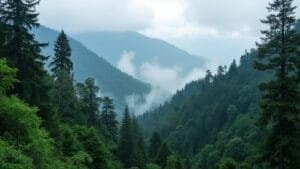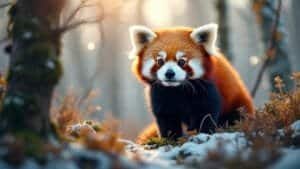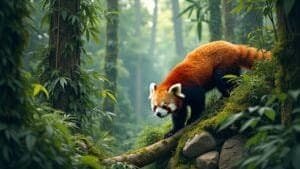Red pandas are elusive, tree-dwelling mammals with very specific nesting needs that are vital to their survival and reproduction in the wild. So, how do red pandas select their nesting sites in the wild? These creatures rely on high-altitude forests rich in bamboo, where they choose nesting sites such as hollow trees, stumps, and rock crevices that provide shelter and safety
Nesting site selection is influenced by elevation, slope orientation, and proximity to food and water sources. In this article, we’ll explore the structures red pandas use for dens, how females prepare nests before birth, the role of environmental features like forest canopy and slope direction, and the seasonal and regional factors that shape their nesting decisions
Red Panda Nesting Behavior in the Wild

High in the misty mountain forests of the Himalayas and southwestern China, red pandas carve out a niche lifestyle that includes careful and selective nesting behavior. These elusive creatures do not build exposed nests like some birds or dig burrows like foxes. Instead, they rely on the structural features of their forest environment to find safe and insulated dens
The choice of nesting site is not random; it is influenced by a combination of safety, accessibility, and environmental conditions that support rearing young in a challenging climate. These behaviors are especially prominent during the birthing season, when female red pandas demonstrate unique nesting instincts essential for cub survival
Natural Structures Used for Nesting
In the wild, red pandas use a range of natural structures for nesting, particularly tree hollows, old tree stumps, logs, and rocky crevices. These spaces provide enclosed, secure environments that help insulate against cold and shield against predators. According to the Smithsonian’s National Zoo, red pandas are tree-dwellers by nature, and when it comes time to nest, they usually locate or repurpose natural cavities found in mature trees or forest debris at elevations ranging from 8,500 to nearly 12,000 feet
Tree hollows are preferred because they are naturally insulated, elevated above ground level, and concealed from predators. These features reduce the chance of detection and offer protection from temperature extremes. In the absence of suitable tree cavities, red pandas have also been known to use dense rock shelters and thickets, particularly in terrain disturbed by logging or landslides. This behavior demonstrates a degree of adaptability, though their reproductive success is typically higher in mature forests with ample hollow trees
Nest Preparation by Female Red Pandas
When preparing to give birth, female red pandas engage in meticulous nest preparation. According to the International Environment Library Consortium (IELC), females begin preparing their dens several days before parturition by collecting insulating materials such as dry grass, moss, leaves, and small sticks. These materials are used to line the interior of the nest, creating a soft and thermally regulated environment for the cubs
This preparation is instinctive and essential for neonatal development. Red panda cubs are born altricial—blind, immobile, and with very sparse fur—making them highly dependent on external insulation for survival. The effort invested by females in nest preparation directly impacts cub survival rates, especially in high-altitude habitats where temperatures can drop below freezing even in summer months
Nest site fidelity is also observed in some populations; if a female has successfully raised cubs in a location before, she may return to the same site in subsequent breeding seasons. However, this behavior depends on the continued safety and integrity of the site, which may be compromised by logging, landslides, or human encroachment
Preferred Elevation Range for Nesting
The elevation range chosen by red pandas for nesting generally overlaps with their core habitat band, which spans approximately 8,500 to 11,800 feet. Within this range, females tend to select mid-level slopes where environmental conditions balance between food access and thermal efficiency. A 2021 study published in Ecology and Evolution found that the densest red panda nest use occurred between 3,250 and 3,400 meters (about 10,660 to 11,150 feet) in Nepal’s Ilam and Taplejung districts
These elevation bands support the growth of specific tree species, such as Himalayan fir (Abies spectabilis) and oak (Quercus spp.), which are more likely to contain natural cavities suitable for nesting. The elevation also determines seasonal snow accumulation and solar radiation—both critical for determining the microclimate of nesting sites
At lower elevations, increased human activity and deforestation often reduce the availability of mature nesting trees. At higher elevations, cold temperatures and reduced forest cover make nesting more thermally challenging. Therefore, the mid-elevation band within the preferred habitat range offers an optimal balance for maternal behavior and cub development
As a complementary resource, readers can explore detailed descriptions of red panda den types and nesting behavior in this expert guide on red panda reproduction and nesting, which includes comparisons between wild and zoo populations
Environmental and Seasonal Factors in Nest Site Selection
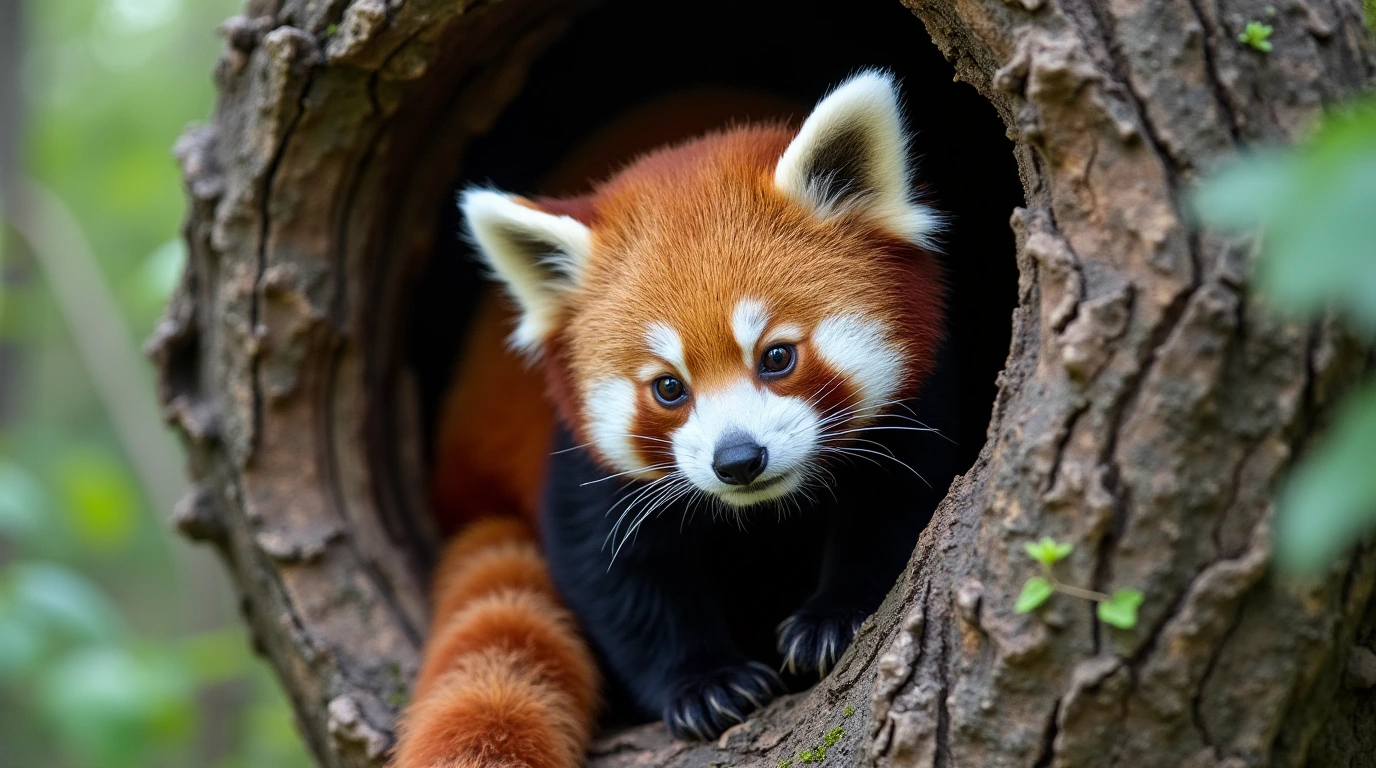
The environmental conditions surrounding a red panda’s nesting site are just as important as the site itself. These animals are remarkably selective when it comes to microhabitat features, and their nesting decisions reflect an intricate understanding of their ecosystem. Elevation, slope direction, forest density, and seasonal changes all contribute to when and where red pandas choose to nest
These fine-scale preferences ensure that cubs are born in thermally stable environments with easy access to food and protection from predators. Understanding these variables is essential for designing effective conservation strategies that safeguard both nesting habitats and broader ecosystem health
Influence of Slope and Forest Canopy
Slope aspect and canopy coverage are two underappreciated but significant factors in red panda nest selection. In the highlands of Nepal and Bhutan, field studies have shown that red pandas often select north- and west-facing slopes for denning. These slopes typically offer cooler and more humid microclimates, which help preserve the integrity of the moss and leaf-lined dens, particularly during dry months. West-facing slopes also benefit from late afternoon sun exposure, providing moderate warmth that reduces the energetic costs of thermoregulation, especially for nursing females and vulnerable cubs
The density of the forest canopy plays a crucial role in shielding nests from predators and environmental extremes. Thick canopy layers regulate ground-level temperature, suppress undergrowth that might otherwise attract competing species, and maintain humidity levels favorable for moss and bamboo. These shaded areas are also less likely to experience erosion or sudden exposure from landslides, making them safer in rugged terrain
Additionally, red pandas avoid steep cliffs or unstable terrain, preferring gentler slopes with stable tree root systems that support hollow formations. In ecosystems dominated by coniferous trees like Tsuga dumosa and Abies spectabilis, which naturally develop cavities as they age, these nesting options are more abundant
Seasonal Variations in Nesting Behavior
Seasonal shifts play a considerable role in how and when red pandas select their nesting sites. Their mating season typically spans from January to March, with cubs born in late spring to early summer (May to July). This timeline aligns with favorable temperatures and bamboo shoot availability, ensuring the female has sufficient nutrition for nursing. In colder seasons, when snow cover becomes persistent at high elevations, red pandas may migrate slightly downward to elevations with less snow accumulation—often by a few hundred feet
Nesting behavior adjusts accordingly. During winter, females may choose dens that receive direct sunlight or are located on lower-elevation slopes with partial canopy gaps to maximize solar gain. Conversely, in summer, dens on higher, shaded slopes are preferred to prevent overheating and maintain stable nest humidity
This seasonal flexibility allows red pandas to mitigate environmental stress but depends heavily on habitat continuity. Fragmented forests disrupt these micro-movements, forcing red pandas to remain in suboptimal or even unsafe sites during critical reproductive phases
A 2023 study in the journal Current Zoology found that red pandas in highly fragmented landscapes showed reduced reproductive success, partially due to a lack of seasonally suitable nesting options. The interplay between seasonal resource availability and thermal safety underscores the red panda’s dependence on intact, multi-elevation forests
Role of Bamboo and Water Source Proximity
The proximity of a nesting site to bamboo thickets and water sources is a defining factor in its viability. Bamboo constitutes nearly 95% of a red panda’s diet, particularly during lactation and cub rearing when energy demands are high. Dens located near dense bamboo growth reduce foraging distances, minimizing energy expenditure and exposure to predators. According to habitat suitability models used by the Red Panda Network, ideal dens are typically within 300 feet of thick bamboo stands
Water sources are equally critical. Red pandas drink frequently due to bamboo’s low moisture content, and studies have shown a strong preference for nesting within close reach of perennial streams or spring-fed pools. This need is heightened during the post-partum period when mothers must hydrate often while remaining near their cubs. A 2014 field survey in Ilam, Nepal, revealed that over 80% of confirmed red panda dens were within 500 feet of a natural water source
Both bamboo and water access also play indirect roles in microhabitat stability. Dense vegetation helps regulate humidity, while nearby water contributes to soil moisture, supporting moss and fern growth around den entrances that further insulate the nest
To explore detailed environmental parameters and habitat dependencies of red pandas, the Smithsonian’s red panda profile offers accessible yet scientifically informed insights into their ecological preferences
Threats and Regional Differences in Nesting Habitats
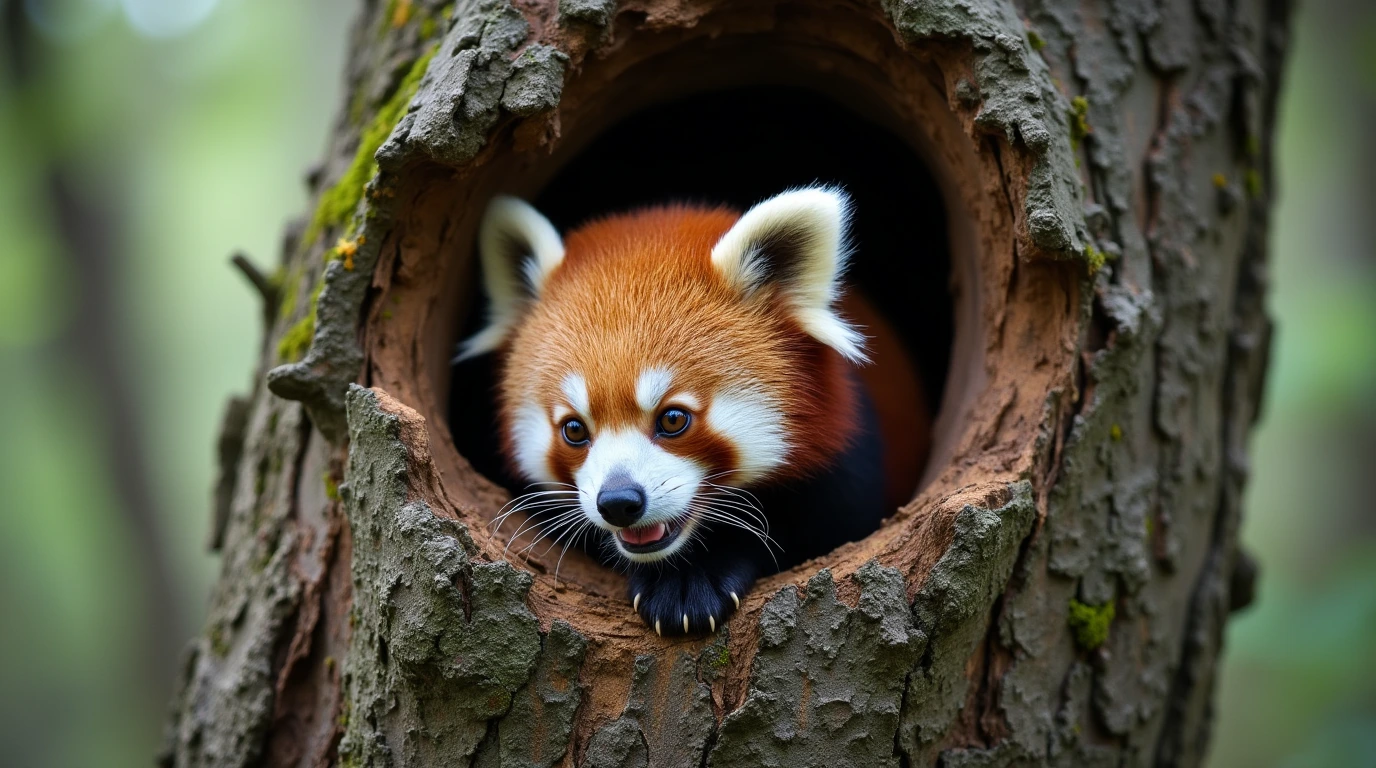
While red pandas are naturally selective and adaptive in how they choose their nesting sites, their options are increasingly constrained by habitat destruction, climate change, and region-specific pressures. These threats vary by location but often result in the same outcome—fewer safe and suitable sites for nesting
Additionally, regional variations in forest composition, climate, and red panda subspecies traits can influence nesting preferences and behaviors. Understanding these complexities is essential for creating targeted, elevation-aware conservation strategies that protect red panda reproductive habitats
Human Impacts on Nest Site Availability
One of the most immediate threats to red panda nesting sites is habitat loss due to deforestation, particularly in the mid-elevation bands where most suitable nesting structures are found. Human activities such as logging, agriculture, infrastructure development, and livestock grazing directly reduce the number of mature trees with natural cavities—the most commonly used nesting sites. According to the Louisville Zoo, red pandas typically nest in old trees or stumps, and these are precisely the types of trees most likely to be harvested for timber or firewood in rural Himalayan communities
Grazing poses an additional indirect threat. Livestock often trample undergrowth and young saplings, preventing the forest from regenerating and reducing the density of bamboo thickets near nesting areas. Moreover, herders frequently clear vegetation to create paths and temporary shelters, further fragmenting red panda habitats. In regions like eastern Nepal and Arunachal Pradesh, these practices have significantly disrupted the continuity of forest corridors, forcing red pandas to either nest in riskier, exposed areas or abandon fragmented ranges altogether
Poaching and disturbance from tourists also play a role. Though red pandas are elusive, human presence near denning sites can lead to abandonment, especially during the sensitive cub-rearing phase. Several conservation field studies, including those by the Red Panda Network, have documented den abandonment linked to increased foot traffic from trekking routes or forest harvesting activity near nesting zones
Climate change compounds these threats by altering the growth patterns of the trees and bamboo that red pandas depend on. As average temperatures rise, tree lines shift upward, reducing the availability of hollow trees at elevations where red pandas prefer to nest. Increased frequency of forest fires, droughts, and bamboo die-offs further strain the resources surrounding potential nest sites
Regional and Subspecies Nesting Differences
Red pandas are divided into two subspecies—Ailurus fulgens fulgens, the Himalayan red panda, and Ailurus fulgens styani, the Chinese red panda. Each subspecies occupies slightly different environments, which may influence their nesting behaviors and preferences
The Himalayan red panda (A. f. fulgens), found in Nepal, India, Bhutan, and Myanmar, typically nests in forests dominated by fir, hemlock, and rhododendron, with ample moss growth and bamboo undergrowth. These habitats are usually located at higher elevations, and the cooler, wetter climate promotes the development of nesting features such as tree hollows and dense understory
In this region, red pandas often nest in areas near north- or west-facing slopes, where the combination of forest canopy and slope aspect creates ideal thermal and protective conditions
In contrast, the Chinese red panda (A. f. styani), found mainly in Sichuan and Yunnan provinces, tends to occupy slightly lower elevations within mixed deciduous and coniferous forests. These forests are often more fragmented and subject to higher human population pressure. As a result, red pandas in China may rely more heavily on rock crevices or managed forest patches for nesting
There’s also evidence that the Chinese subspecies, with its slightly darker and thicker coat, may be more tolerant of cooler microclimates, which could broaden its nesting altitude range slightly compared to its Himalayan counterpart
Overall, while both subspecies rely on similar core habitat features—tree hollows, bamboo proximity, and forest density—the specific availability and structure of these features vary by region. Conservation planning must take into account these localized habitat differences to ensure that efforts to protect nesting areas are both geographically and biologically relevant
To dive deeper into how red panda subspecies differ in nesting and morphology, visit the Louisville Zoo’s red panda profile for more regional insights and educational resources


